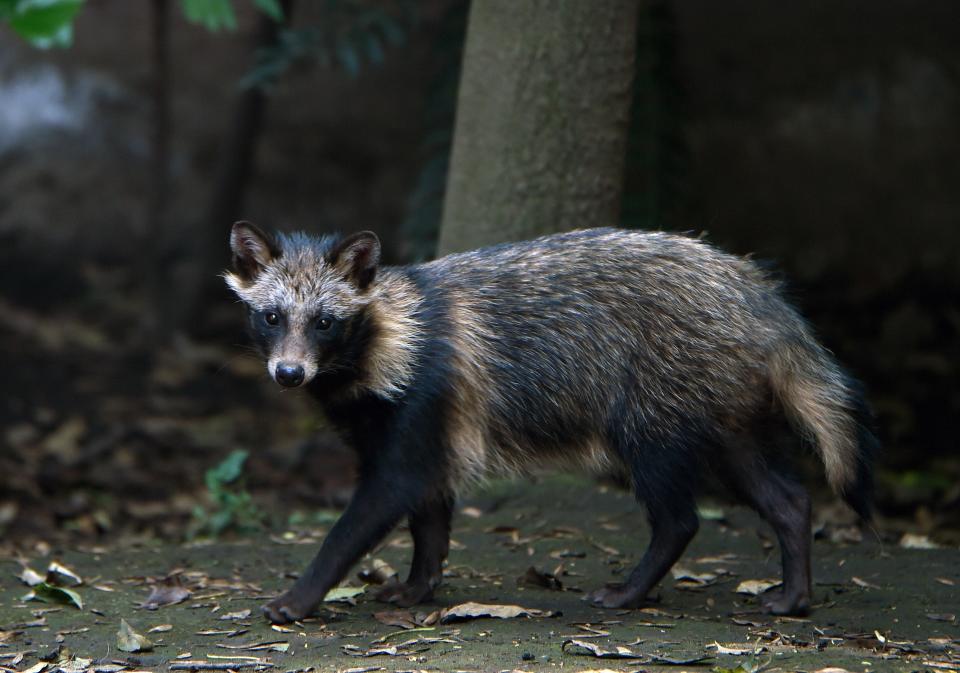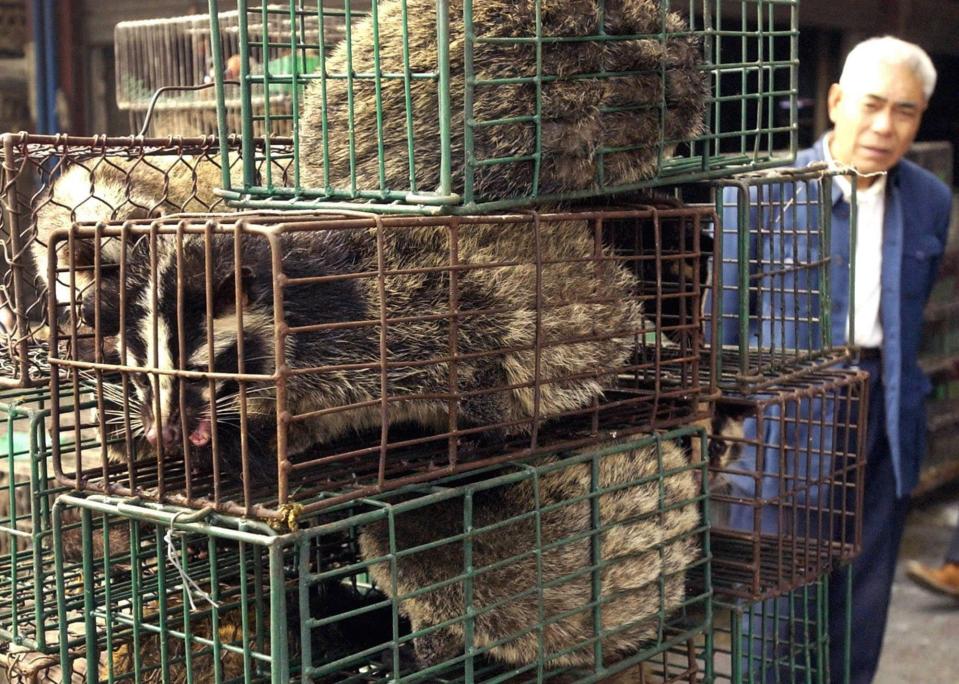Are these furry creatures to blame for the pandemic? Study finds 'reasonable' origin of COVID
Raccoon dogs, a spaniel-size canine bred and sold in China both for their meat and luxurious fur, are one of the likeliest sources of the last 2½ years of human misery.
A new study suggests these furry creatures, native to Asia, may have been the intermediary, catching the SARS-CoV-2 virus from bats and passing it on to people at a Chinese market, leading to the global COVID-19 pandemic.
There's no way to know for certain because animals sold at the market were never tested. But samples taken from cages and carts used to house and transport raccoon dogs at the Huanan Seafood Market in Wuhan, China, in late 2019 contained traces of the virus, said Chris Newman, a biologist, ecologist and research associate with Oxford University, and a co-author on the paper.
"As far as the virologists are concerned, looking at the evolutionary strain of the virus itself, it's perfectly reasonable that (SARS-CoV-2) evolved in a bat and then spread through the raccoon dog as the primary intermediary," Newman said.
So-called wet markets, which sell both meat and live animals, have been shuttered across China since the start of the pandemic, Newman said, although they still operate in other countries.
Wet markets often keep animals in what most people would consider appalling conditions, which can foster disease. Newman described cages of raccoon dogs and other mammals such as marmots stacked high, where the urine and feces of the animals in upper cages rain down on the lower ones, potentially passing viruses and bacteria.
The animals are "slaughtered on demand and not in a particularly nice way," Newman said. At fur farms, raccoon dogs and foxes are skinned alive or electrocuted; in markets, the vendor butchers them with a knife, providing what consumers would consider the freshest possible meat.
Although currently available data cannot provide beyond a shadow of a doubt that this is where SARS-CoV-2 made the jump to people, Newman and others said it's a particularly plausible route.
Research shows that raccoon dogs can be infected with and shed the SARS-CoV-2 virus, though they don't become visibly ill, said Thomas Müller, a veterinarian, who was involved in one of the studies.

Was a wet market ground zero?
There were potentially many other locations in Wuhan, a city of 11 million, where the virus could have originated, but the new study, published in the peer-reviewed, well-respected journal "Science," investigated multiple options, all of which home in on that particular market.
In a detailed Twitter thread posted in late July, study co-author Angela Rasmussen, a virologist, wrote that all available data – and there are plenty – points to the seafood market as the origination point, rather than a research laboratory in the same city, as some have speculated.
"Although many questions remain, these provide conclusive evidence that SARS-CoV-2 emerged via at least 2 zoonotic spillovers from animals sold at Huanan," she wrote, referencing a term that describes pathogens jumping from animals to people. "Yes, the data is incomplete and imperfect, but it overwhelmingly shows that the pandemic began at Huanan through zoonosis, not at the WIV (Wuhan Institute of Virology) or any other lab."
The Huanan market has long been suspected as the point of origin for SARS-CoV-2.
W. Ian Lipkin, an epidemiologist and director of the Center for Infection and Immunity at the Mailman School of Public Health at Columbia University, said it was seen as the likeliest site back in January 2020 when he met with colleagues in Beijing to discuss what was then a relatively small outbreak of an as-yet-unnamed new disease.
The study reflects "excellent work," Lipkin said.
"Nonetheless, it does not unequivocally prove a market origin, and won’t convince those who feel the origin was a laboratory leak," he said.
Since long before COVID-19, Lipkin has argued that wild animal markets like Huanan are dangerous and should be shuttered worldwide.
More controls should also be added to laboratory research that involves wildlife, he said.
"Irrespective of the high probability that this or another wild animal market triggered the pandemic, work with materials from wildlife should only be conducted in biocontainment," Lipkin said, referring to lab protocols that reduce the risks of transmitting pathogens.
Any contact wild animals have with humans poses a disease risk that can go either way, said Müller, who specializes in virology and epidemiology at the Friedrich-Loeffler-Institut in Riems, Germany. Pigs can catch the flu from humans and visa versa, he noted.
"The closer the contact, the higher the risk," he said.
Many diseases are known to come from wild animals, including Ebola, Zika, flu, plague, Lyme disease and rabies. The first SARS virus, detected in China in 2002, was believed to have traveled from a bat to a palm civet, a cat-size creature with a long furry tail and a pointed snout, before making the jump to people.

Humans have increased the risk for these zoonotic diseases in recent years, Müller said, by encroaching on territory used by wild animals through logging, hunting and urbanization, as well as attitudes that view all animals as potential pets rather than potential dangers.
"Any kind of risk-mitigating measures in terms of human behavior – that is key to avoiding these cross-species transmission events in the future," Müller said.
Don't bring one of these home
Raccoon dogs were introduced to eastern parts of Europe, particularly Russia, in the 1930s, as a new fur species, Müller said.
Since then, they've spread to central and western Europe.
"It's almost impossible to get rid of these species anymore," said Müller, who has studied them as part of rabies-eradication efforts. "They have well adapted and have established sometimes pretty high population densities, especially in the central European countries."
Raccoon dogs, like raccoons, are generally nocturnal creatures that hide from rather than attack other animals.
"They are not aggressive at all," Müller said. "You would hardly see them in nature."
They are cute and impressive animals, he said, but according to the Royal Society for the Prevention of Cruelty to Animals, the British version of the ASPCA, raccoon dogs make terrible house pets.
They require wide ranges for roaming, far bigger than an urban apartment or suburban yard. Communicating with each other via scent, raccoon dogs also smell horrible to humans, the RSPCA said.
It is illegal to breed raccoon dogs in Europe or sell any but existing stock.
Selling wild raccoon dogs has also long been illegal in China, Newman said, but that regulation was not well enforced before the discovery of SARS-CoV-2.
About 40 million raccoon dogs are bred in China for their fur, roughly 99% of the animal's global population, Müller said. He is not aware of any testing done to look for SARS-CoV-2 among farm-bred raccoon dogs.
Raccoon dogs are not the only potential animal source for SARS-CoV-2, Newman said.
There are a number of animal species that can spread the virus and that humans can spread back into animals. These include minks, which were slaughtered by the millions in Denmark, after they were discovered to carry the virus.
Like mink, other small animals that burrow underground, such as badgers, hog badgers and weasels, "all of these animals that have a subterranean, denning lifestyle seem to be particularly susceptible," Newman said.
Like minks and badgers, raccoon dogs like to live in burrows or caves, where they potentially came into contact with bats, either by eating them or cohabitating with them.
Zoos have had to vaccinate many of their animals, particularly primates and even big cats, against COVID-19, because they are susceptible to catching the virus from their human caretakers, Newman said. Deer, which are prone to respiratory infections, have also been known to contract the virus, and he suggests hunters wear masks when butchering or otherwise coming into close contact with deer.
Pets like cats and dogs can catch COVID-19 from people but do not seem to commonly pass it back, Newman said.
"Sticking with farmed animals, sticking with domesticated animals and sticking with animals that are produced and slaughtered and processed in accordance with the public health service would seem to be the way to go," he said.
Contact Karen Weintraub at kweintraub@usatoday.com.
Health and patient safety coverage at USA TODAY is made possible in part by a grant from the Masimo Foundation for Ethics, Innovation and Competition in Healthcare. The Masimo Foundation does not provide editorial input.
This article originally appeared on USA TODAY: Origins of COVID pandemic can be traced to Chinese market, study finds

 Yahoo Movies
Yahoo Movies 
